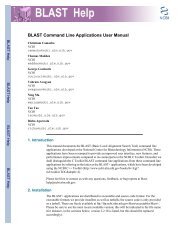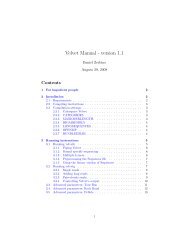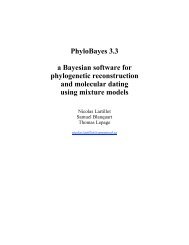PAUP* 4.0 Beta: Command Reference --Draft Version 3--
PAUP* 4.0 Beta: Command Reference --Draft Version 3--
PAUP* 4.0 Beta: Command Reference --Draft Version 3--
You also want an ePaper? Increase the reach of your titles
YUMPU automatically turns print PDFs into web optimized ePapers that Google loves.
<strong>Command</strong>s used in the TREES Block<strong>Command</strong> <strong>Reference</strong>considered unrooted and the comment ’[&R]’ indicates that the tree shouldbe considered rooted. For example:tree mytree = [&R] ((1,2),(3,4));is a rooted tree, whereastree mytree = [&U] ((1,2),(3,4));is an unrooted tree. You will usually define unrooted trees. These trees arethen rooted for output purposes using the outgroup or Lundberg rootingprocedures. However, if you wish to define an ancestor for the full tree (seeANCSTATES command), if you are using directed characters, or if you wantto evaluate trees under a maximum likelihood "clock" constraint you maywish to define rooted trees instead. In any case, you can convert rootedtrees to unrooted trees and vice versa using the ROOTTREES/DEROOTTREEScommands.Note that in order to write the tree descriptions, unrooted trees may berooted at any convenient point (including a terminal taxon or internalnode); the position of the root is simply ignored when the tree is stored.Another "special comment" stored in the TREES block and used by <strong>PAUP*</strong>is the tree weight comment. Tree weights are the reciprocal of the numberof trees found in either a BOOTSTRAP or JACKKNIFE replicate. This optionallows the combination of bootstrap results from runs performed atdifferent times or on different machines and the recovery of resultsobtained prior to a system crash. For example the TREEFILE created by theBOOTSTRAP command might look like this:[Trees found in bootstrap replicate #1]tree B_1.1 = [&W 1] (1,((((2,4),5),3),6));[Trees found in bootstrap replicate #2]tree B_2.1 = [&W 1/2] (1,((((2,4),5),6),3));tree B_2.2 = [&W 1/2] (1,(((2,4),(5,6)),3));An example tree with branch lengths istree PAUP_1 = [&U] (1:22,(2:12,3:9):9,4:72);<strong>PAUP*</strong> currently ignores the tree names; trees are referred to subsequentlyonly by number, in the order in which they are presented in the TREESblock. (MacClade uses the tree names, however.) If the name is precededby an asterisk (*), the tree becomes the "default" tree. (E.g., aDESCRIBETREES command with no tree list will result in the description ofthe default tree.)If a taxon is omitted from the tree specification, it is assumed to descendfrom the root of the tree described by the remaining taxa.26 February, 2002 <strong>PAUP*</strong> <strong>4.0</strong> beta documentation





